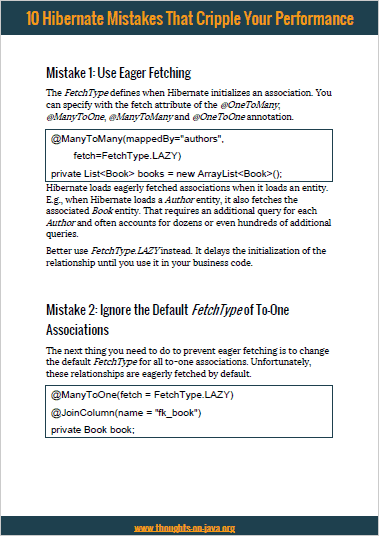Hibernate Tips: How to map an entity to multiple tables
Take your skills to the next level!
The Persistence Hub is the place to be for every Java developer. It gives you access to all my premium video courses, monthly Java Persistence News, monthly coding problems, and regular expert sessions.
Hibernate Tips is a series of posts in which I describe a quick and easy solution for common Hibernate questions. If you have a question for a future Hibernate Tip, please leave a comment below.
Question:
I’m working with a legacy database, and I need to map an entity to 2 database tables. Is there any way to do that with JPA or Hibernate?
Solution:
Yes, you can map an entity to 2 database tables in 2 simple steps:
- You need to annotate your entity with JPA’s @Table and @SecondaryTable annotations and provide the names of the first and second table as the value of the name parameters.
- You need to annotate each attribute which you want to map to the secondary table with a @Column annotation and set the name of the secondary table as the value of the table attribute.
Map the Author entity to 2 tables
Let’s take a look at a simple example that maps the author and the author_details table to the Author entity. Here are the 2 tables:
The following code maps these tables to the Author entity.
The @Table annotation defines the primary table to which the entity attributes get mapped by default. In this example, that’s the case for the id, version, firstName, and lastName attributes.
The @SecondaryTable annotation specifies the second database table to which the entity gets mapped. It consists of the columns id, pseudonym, and category. You need to annotate the attributes that map these columns with an additional @Column annotation that provides the name of the secondary table.
@Entity
@Table(name = "author")
@SecondaryTable(name = "author_details")
public class Author {
@Id
@GeneratedValue(strategy = GenerationType.AUTO)
@Column(updatable = false, nullable = false)
private Long id;
@Version
private int version;
private String firstName;
private String lastName;
@Column(table = "author_details")
private String pseudonym;
@Column(table = "author_details")
private Category category;
...
}
That’s all you need to do to map the 2 database tables to the Author entity. Every time you persist or update an Author entity, Hibernate writes the values of the id, firstName, lastName, and version attributes to the author table, and the values of the id, pseudonym, and category attributes to the author_details table.
And when you read an Author entity, Hibernate gets the attribute values from the same 2 tables.
EntityManager em = emf.createEntityManager();
em.getTransaction().begin();
Author a = new Author();
a.setFirstName("Thorben");
a.setLastName("Janssen");
a.setCategory(Category.NON_FICTION);
a.setPseudonym("Thorben Janssen");
em.persist(a);
em.getTransaction().commit();
em.close();
As you can see in the log output, Hibernate uses the name and value of the primary key column of the primary table also as the name and value of the primary key column of the secondary table.
09:12:40,154 DEBUG [org.hibernate.SQL] -
select
nextval ('hibernate_sequence')
09:12:40,204 DEBUG [org.hibernate.SQL] -
insert
into
author
(firstName, lastName, version, id)
values
(?, ?, ?, ?)
09:12:40,218 TRACE [org.hibernate.type.descriptor.sql.BasicBinder] - binding parameter [1] as [VARCHAR] - [Thorben]
09:12:40,218 TRACE [org.hibernate.type.descriptor.sql.BasicBinder] - binding parameter [2] as [VARCHAR] - [Janssen]
09:12:40,219 TRACE [org.hibernate.type.descriptor.sql.BasicBinder] - binding parameter [3] as [INTEGER] - [0]
09:12:40,222 TRACE [org.hibernate.type.descriptor.sql.BasicBinder] - binding parameter [4] as [BIGINT] - [1]
09:12:40,225 DEBUG [org.hibernate.SQL] -
insert
into
author_details
(category, pseudonym, id)
values
(?, ?, ?)
09:12:40,225 TRACE [org.hibernate.type.descriptor.sql.BasicBinder] - binding parameter [2] as [VARCHAR] - [Thorben Janssen]
09:12:40,226 TRACE [org.hibernate.type.descriptor.sql.BasicBinder] - binding parameter [3] as [BIGINT] - [1]
Customize the primary key columns
The previous example didn’t specify the name of the primary key column in the secondary table. By default, Hibernate uses an identical mapping to map the primary key attribute to both tables. If you’re working with a legacy database, you might need to adapt this for the secondary table.
You can do that with the pkJoinColumns attribute of the @SecondaryTable annotation. It allows you to customize the mapping with one or more @PrimaryKeyJoinColumn annotations. Its name attribute specifies the name of the primary key column of the secondary table and the referencedColumnName attribute defines the name of the primary key column of the primary table.
@Entity
@Table(name = "author")
@SecondaryTable(name = "author_details", pkJoinColumns = @PrimaryKeyJoinColumn(name = "authorId", referencedColumnName = "id"))
public class Author { ... }
When you now persist a new Author entity, Hibernate uses the authorId column as the primary key column of the author_details table.
09:13:34,254 DEBUG [org.hibernate.SQL] -
select
nextval ('hibernate_sequence')
09:13:34,315 DEBUG [org.hibernate.SQL] -
insert
into
author
(firstName, lastName, version, id)
values
(?, ?, ?, ?)
09:13:34,321 TRACE [org.hibernate.type.descriptor.sql.BasicBinder] - binding parameter [1] as [VARCHAR] - [Thorben]
09:13:34,323 TRACE [org.hibernate.type.descriptor.sql.BasicBinder] - binding parameter [2] as [VARCHAR] - [Janssen]
09:13:34,324 TRACE [org.hibernate.type.descriptor.sql.BasicBinder] - binding parameter [3] as [INTEGER] - [0]
09:13:34,327 TRACE [org.hibernate.type.descriptor.sql.BasicBinder] - binding parameter [4] as [BIGINT] - [1]
09:13:34,330 DEBUG [org.hibernate.SQL] -
insert
into
author_details
(category, pseudonym, authorId)
values
(?, ?, ?)
09:13:34,331 TRACE [org.hibernate.type.descriptor.sql.BasicBinder] - binding parameter [2] as [VARCHAR] - [Thorben Janssen]
09:13:34,331 TRACE [org.hibernate.type.descriptor.sql.BasicBinder] - binding parameter [3] as [BIGINT] - [1]
Learn more:
If you enjoyed this post, you might also be interested in the following posts about entity mappings:
- Hibernate Tips: How to Map Multiple Entities to the Same Table
- Hibernate Tips: How to escape table and column names
- Hibernate Tips: How to define schema and table names
Hibernate Tips Book

Get more recipes like this one in my new book Hibernate Tips: More than 70 solutions to common Hibernate problems.
It gives you more than 70 ready-to-use recipes for topics like basic and advanced mappings, logging, Java 8 support, caching, and statically and dynamically defined queries.



Not just this article, I have checked many of your articles, every time, to learn something. Thanks for posting brilliant articles and helping the IT community!
Nice article Thorben.
Thanks